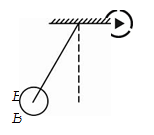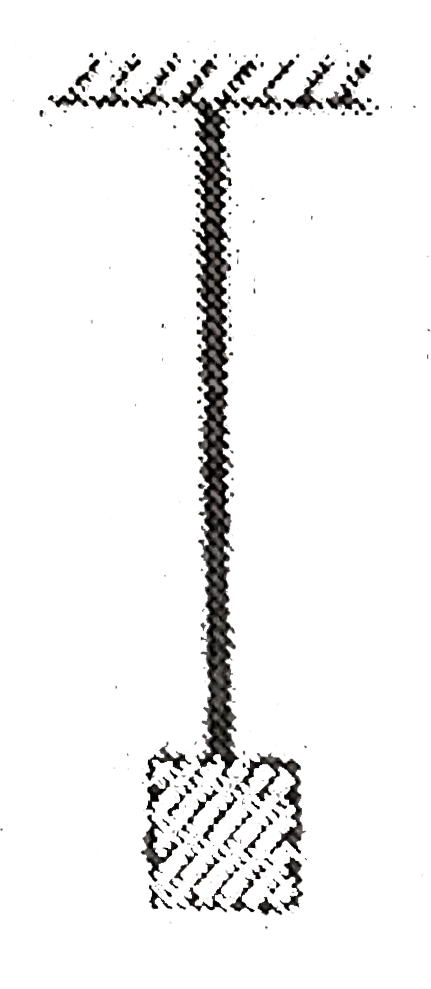Which of the following examples represent periodic motion?
(a) A swimmer completing one (return) trip from one bank of a river to the other and back.
(b) A freely suspended bar magnet displaced from its N-S direction and released.
(c) A hydrogen molecule rotating about its centre of mass.
(d) An arrow released from a bow.
(a) It is not a periodic motion. Though the motion of a swimmer is to and fro but will not have a definite period. (b) It is a periodic motion because a freely suspended magnet if once displaced from N-S direction and let it go, it oscillates about this position. Hence it is simple harmonic motion also. (c) It is also a periodic motion , (d) It is not a periodic motion.
Similar Questions
Which of the following examples represent periodic motion?
(a) A swimmer completing one return trip from one bank of a river to other bank. (b) A freely suspended bar magnet displaced from its N−S direction and released. (c) A hydrogen molecule rotating about its centre of mass. (d) An arrow released from a bow.
View SolutionWhich of the following examples represents periodic motion ?
(i) A swimmer completing onė (return) trip from one bank of a river to the other bank.
(ii) A freely suspended bar magnet displaced form its N-S direction and released.
(iii) Halley's comet
(iv) A hydrogen molecules rotating about its centre of mass.
(v) An arrow released from a bow.
View SolutionWhich of the following examples represent (nearly) simple harmonic motion and which represent periodic but not simple harmonic motion?
(a) The rotation of earth about its axis. (b) Motion of an oscillating mercury column in a U tube,
(c) Motion of a ball bearing inside a smooth curved bowl, when released from a point slightly above the lower most position. (d) General vibrations of a polyatomic molecule about its equilibrium position.
View SolutionA metal rod of length 'L' and mass 'm' is pivoted at one end. A thin disk of mass 'M' and radius 'R' (< L) is attached at its centre to the free end of the rod. Consider two ways the disc is attached: (case A) - The disc is not free to rotate about its centre and (case B) - the disc is free to rotate about its centre. The rod-disc system after being released from the same displaced position. Which of the following statement(s) is(are) true?

View SolutionWhich of the following examples represents (nearby) shm and which represents periodic but not shm.
(i) The rotation of earth about its axis.
(ii) Motion of an oscillating mercury column in a U-tube.
(iii) Motion of a ball bearing inside a smooth curved bowl when released from a point slightly above the lowermost position.
(iv) General vibration of a polyatomic molecules about its equilibrium configuration.
View SolutionWhich of the following statements are true about acceleration due to gravity ?
(a) 'g' decreases in moving away from the centre if r>R
(b) 'g' decreases in moving away from the centre if r<R
( c ) 'g' is zero at the centre of earth
(d) 'g' decreases if earth stops rotating on its axis
View SolutionA metal rod of length 'L' and mass 'm' is piovted at one end. A thin disk of mass 'M' and radius 'R'(<L). Is attached at its centre to the free end of the rod. Consider two ways the disc is attached: (case A). The disc is not free to rotate about its centre and (case B) the disc is free to rotate about its center. The rod-disc sustem perform SHM in vertical plane after being released from the same displaced potion. Which of the following statement(s) is (are) true?

View SolutionA wire of length l, area of cross-section A and Young,s modulus of elasticity Y is suspended form the roof of a building. A block of mass m is attached at lower end of the wire. If the block is displaced from its mean position and released then the block starts oscillating. Time period of these oscillations will be

View Solutionin which fo the following cases the centre of mass of a rod is certainly not at its centre?
(A) The density continuously increases from left ot right
(B) The density continuously decreases from left to right
(C) The density decreases from left to right up to the centre and then increases
(D) The density increases from left to right up to the centre and then decreases
Select correct alternative.
View SolutionA uniform electric field of intensity E=106V/m exist in vertically downwards direction in a region. A particle of mass m = 0.01 kg and charge q=10−6C is suspended byan inextensible thread of length I=1m. The particle is displaced slightly from its mean position and released. Calculate the time period of its oscillation. What minimum velocity should be given to the particle at rest from its equilibrium position so that it completes a full circle in vertical plane? Calculate the maximum and minimum tension in the thread in its circular motion in vertical plane. [0.6s,23.42m/s,6.59N,0]
View Solution
